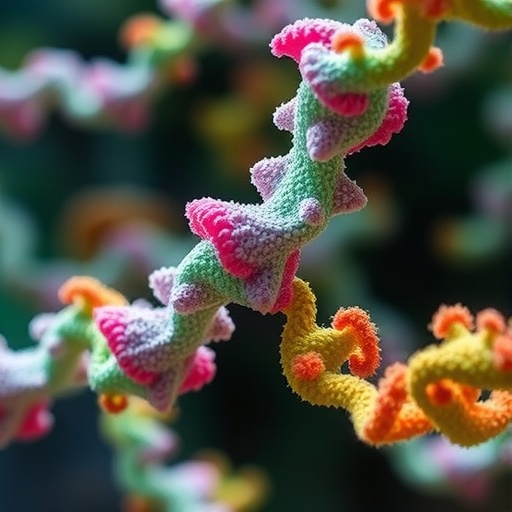In a groundbreaking exploration into one of biology’s most enduring enigmas, researchers at the Hebrew University of Jerusalem have unveiled evidence shedding light on why life on Earth universally employs alpha amino acids as the foundational building blocks of proteins. This revelation pivots on the fundamental chemistry of peptide backbones and their intrinsic propensity to self-assemble into stable supramolecular structures under prebiotic conditions, suggesting an evolutionary advantage that may have shaped the earliest molecular architectures of life.
The study, spearheaded by Dr. Moran Frenkel-Pinter and her team, delves into primitive peptide-like molecules called depsipeptides, which are hybrids containing both ester and amide bonds. These molecules are hypothesized to have formed spontaneously on early Earth due to their relative ease of synthesis in prebiotic environments, despite their inherently lower stability compared to modern peptides. By synthesizing depsipeptides with varied amino acid backbones—specifically those derived from alpha and beta amino acids—the researchers were able to directly compare their assembly behaviors and stabilities in aqueous conditions.
One of the most striking findings of this study is that depsipeptides formed from alpha amino acids consistently generated robust, droplet-like assemblies capable of enduring physical stresses such as freezing and thawing cycles. These compartmentalized structures persisted for weeks, indicating a remarkable resilience not observed in analogous assemblies derived from beta amino acids. Beta-based depsipeptides, when they assembled at all, demonstrated rapid phase separation and a pronounced tendency to disintegrate, pointing to a fundamental mechanistic difference in how molecular backbone topology influences higher-order assembly.
This discovery invigorates the longstanding question of why nature settled on a canonical set of 20 alpha amino acids for protein construction when alternative forms such as beta and gamma amino acids were present in the primordial milieu. The researchers propose that the enhanced self-assembly and stability traits intrinsic to alpha-based peptides provided a crucial selective pressure during chemical evolution. This assembly-driven selection would have favored molecular frameworks capable of forming enduring, compartment-like microenvironments—a prerequisite for early metabolic pathways and information storage.
The implications of this work extend beyond the origin-of-life narrative, contributing fundamentally to our understanding of molecular self-organization principles. Self-assembly is increasingly recognized as a cornerstone of biological complexity, not merely facilitating structural order but enabling the spatial segregation necessary for life’s chemical reactions. The resilience of alpha-based assemblies under destabilizing environmental conditions underscores their potential role as primitive protocells, bridging nonliving chemistry and living systems.
In experimental terms, the team employed a variety of hydroxy and amino acids to synthesize depsipeptides, closely mimicking prebiotic chemical scenarios. The emphasis on depsipeptides as proto-peptides is particularly notable, as this class bridges the gap between the easily synthesized ester-rich molecules and the peptide bonds central to modern proteins. The dual-functional nature of depsipeptides offers critical insights into transitional chemistries and highlights the evolutionary fitness landscape that early molecular systems might have navigated.
Dr. Frenkel-Pinter emphasized the evolutionary significance of this structural stability, stating, “Our findings suggest that the superior ability of alpha-based proto-peptides to self-assemble into stable compartments could have provided them with a decisive advantage in chemical selection processes that preceded genetics.” This perspective aligns with emerging models of chemical evolution which frame molecular assembly and compartmentalization as essential drivers rather than secondary byproducts of life’s genesis.
The research also touches on the broader implications across disciplines. As Sarah Fisher, a co-leader of the project, highlighted, “Understanding how simple molecules self-organize not only informs prebiotic chemistry but also could influence the design of novel biomaterials and pharmaceuticals.” Indeed, the principles governing peptide assembly may inspire new strategies in drug delivery and biomaterial engineering, leveraging the innate stability and functional versatility of alpha-peptide architectures.
Further adding to the novelty, the research is the first to systematically compare the assembly behaviors of alpha and beta proto-peptide backbones, offering a direct experimental lens on molecular evolution’s choices. This comparative approach underscores that not only chemical reactivity but also physical assembly properties were critical parameters in early molecular selection schemes.
The profound durability of alpha-based assemblies observed might have enabled localized reaction networks, facilitating the compartmentalization and concentration of molecules essential for the emergence of metabolisms. These stable, droplet-like formations bear resemblance to modern membraneless organelles, suggesting that the seeds of cellular compartmentalization were sown at the molecular assembly level well before the advent of lipid membranes.
Ultimately, this study introduces an assembly-driven selection model that enriches the theoretical landscape of origins of life research. By focusing on molecular topology and supramolecular stability, it provides a compelling narrative that integrates chemical feasibility, structural biology, and evolutionary dynamics into a cohesive framework explaining life’s molecular predispositions.
This pioneering work not only advances our understanding of the physicochemical underpinnings of early life but also opens new frontiers for interdisciplinary research. From prebiotic chemistry and molecular biology to synthetic bioengineering and materials science, the implications of assembly-driven molecular selection are poised to resonate widely, reflecting the profound influence of molecular form and function at life’s dawn.
Subject of Research: Not applicable
Article Title: Protopeptide backbone affects assembly in aqueous solutions
News Publication Date: 3-Oct-2025
Web References: DOI: 10.1073/pnas.2500503122
Image Credits: Frenkel-Pinter Lab
Keywords
Amino acids, Peptides, Proteins, Biomaterials, Bioengineering




